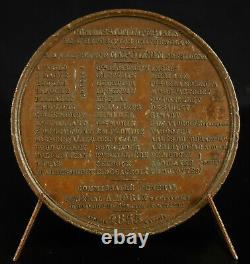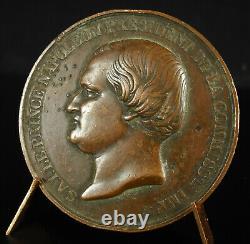Medal Le Prince Napoleon Commission Imperial of the Exhibition 1855 1 15/16in





215- TIR93 Copper medal from the Monnaie de Paris (Handmark from 1845 to 1860). Note the names of: Mérimé, de Lesseps, Ingres, etc. Engraver : Barré, Gervais & co editor.
Hallmark on the edge: hand + copper. The easel is not for sale.
The stan d is not for sale. The Universal Exhibition of 1855 is an international fair-type event for commercial and cultural purposes that took place in Paris in 1855. This is the first French Universal Exhibition (and the second worldwide, the first being the 1851 Universal Exhibition in London). It was held in Paris on the Champs-Élysées from May 15 to November 15, 18552. It welcomed more than 5,100,000 visitors.
Twenty-five states and their colonies participate. It was by an imperial decree of March 8 Mars 1853, that Napoleon III decided to hold a Universal Exhibition in Paris in 1855, where agricultural and industrial products will be exhibited, following the first Universal Exhibition of 18514. The same decree authorizes the admission to this Exhibition of products from all nations. The Five-Year Exhibition, which was to take place in 1854, was therefore postponed and reunited at the Universal Exhibition.
Another decree of June 22 decides in turn that a Universal Exhibition of Fine Arts will be held at the same time as the Universal Exhibition of Industry. An Imperial Commission, having Prince Napoleon5 as president and Arlès-Dufour as secretary general, was formed on December 24, with the task of organizing these major events. This commission comprises two sections: the Fine Arts section where we find the names of Prosper Mérimée, Eugène Delacroix and Ingres and the Agriculture and Industry section where we find the names of Charles Legentil, Frédéric Le Play, Ferdinand de Lesseps, Emile Pereire, Michel Chevalier6. The first task of the commission is to ask the prefects to organize a committee in each of the departments and to invite foreign governments to participate and appoint commissioners to the Exhibition. Plan and location of the Expo buildings The exhibition inauguration engraving Inauguration by Napoleon III of the Universal Exhibition in the Palais de l'Industrie (colored lithograph by Louis-Jules Arnout) The chosen location is the triangle formed by the Champs-Élysées, the Cours de la Reine and Avenue Montaigne.
The 1851 World's Fair in London excited the spirit of competition and: No sooner had the doors of the Palais de Cristal been closed than from all sides people began to claim for Paris the honor of such a competition7. May 15, 1855 is the day of the official inauguration. Unfortunately the sun did not favor its solemnity.
It was overshadowed, on the contrary, by rainy and cold weather, which the spring date could never have predicted. The opening ceremony takes place in the Palais de l'Industrie in front of a large and international audience. Despite the Crimean War9 and the battles of the French Navy in the Baltic, the Exhibition celebrates the economic collaboration of Nations. The palace of industry Main article: Palace of Industry. Engraving: The Palace of Industry Palace of Industry next to the Champs-Élysées engraving: The Palace north face North facade of the Palace of Industry To host the Exhibition, a gigantic building10, the Palais de l'Industrie, was built along the Champs-Élysées. Originally, the building was planned to house the National Exhibitions which have been held since the Revolution in poorly adapted premises. The design of the building is the result of the collaboration of architect Jean-Marie Victor Viel and engineers Alexis Barrault and Georges Bridel. The 208-meter-long façade opened onto a monumental portal in the form of a triumphal arch, the cornice of which is decorated with an allegorical group of France crowning Art and Industry with gold, the work of the sculptor Elias Robert. This France is framed by groups of putti bearing the imperial arms which are the work of the sculptor Georges Diebolt11. The four facades are pierced by a double row of semicircular windows; between the two stories of windows runs a frieze on which are engraved the names of the great men of humanity. This building is a technical feat. For the first time, wrought iron beams were used, supported by cast iron columns. The barrel vault of the central nave, with a span of 48 metres, rests on the columns, without the need for tie rods. Buttresses are used to thwart the thrusts of the roof and huge blocks of lead serve as abutments.It is obvious, very quickly, that there is not enough space to receive all the exhibitors nearly 24,000, half of whom are French4 and the Imperial Commission is studying the possibility of creating annexes. A connecting gallery was therefore built which linked the Palace to the Rotunda of the Panorama12, which was nevertheless destined for demolition, then a new connecting gallery connected the Rotunda to the annex gallery.
The adjoining gallery of the machines. The four facades are pierced by a double row of semicircular windows; between the two stories of windows runs a frieze on which are engraved the names of. This item is in the category "Coins & Paper Money\Exonumia\Medals".
5" and is located in this country: FR. This item can be shipped worldwide.

